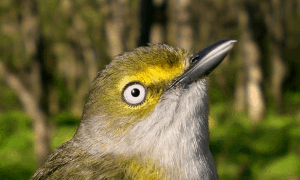
It was a productive but generally uneventful wrap-up to the spring coverage season. Migrants were few and far between apart from small numbers of shorebirds, a few flycatchers, Cedar Waxwings, and ones-and-twos of a variety of vireos and warblers. Local breeders made up more than 95% of the birds encountered from the 1st to the 10th. Five mornings of rain also played a part and, as a result, very little banding was conducted during the summary period.
Daily species diversity ranged from a low of 25 on June 2nd to a high of 37 on the 4th. Passage migrants (species that don’t nest on the island) were limited to Red-breasted Merganser (June 9th), Ruddy Turnstone (June 3rd & 4th), 2 Lesser Black-backed Gulls (June 6th), Red-breasted Nuthatch (June 7th), and Yellow-bellied Flycatcher (June 2nd & 3rd). A singing Acadian Flycatcher was recorded on census on the 4th.
In all, PIBO staff and volunteers conducted 71 mornings of consecutive coverage (less one day) at the point this spring from April 1st to June 10th and recorded 170 species during our official count period. PIBO’s average spring species total over ten years is 172. Unusual species documented included “Yellow” Palm Warbler (April 17th), Willet (April 20th), Prothonotary Warbler (April 25th plus numerous dates), Louisiana Waterthrush (April 27th), Henslow’s Sparrow (April 29th), “Brewster’s” Warbler (May 4th), Dickcissel (May 20th), Acadian Flycatcher (May 23rd, 25th, June 4th), and Connecticut Warbler (May 25th). A total of 32 warbler species and forms was noted this spring in PIBO’s official count area.
Based on the average daily catch-rate, it was PIBO’s quietest spring for banding, with 532 birds captured of 63 species in 1321 net-hours, for an average catch-rate of 0.40 birds/net-hour (10 year average 0.58). Despite the relatively low numbers, a nice variety of species were handled including 2 White-eyed Vireos, 2 Golden-winged and 2 Hooded Warblers, and singles of Acadian Flycatcher, Prothonotary Warbler, and Louisiana Waterthrush. Twenty-six warbler species were banded. There were no mortalities this spring during the banding operation. PIBO’s current mortality rate over ten years is 1 for every 860 birds handled, or approximately four per year (spring and fall).
It was another successful season of standardized monitoring at Fish Point – our 11th – and a very productive spring for PIBO’s outreach and education programs. Along with a number of presentations at local high schools on the mainland, PIBO hosted 150 visitors at the banding lab, including three school groups. Other positive develops included our second annual fundraising dinner in Windsor and another successful community sausage picnic on the island.
Thanks very much to all our supporters, both large and small, including author Elizabeth Hay, Jim Wigle from Ontario Parks, Ken Burrell, for his help in the field, and the residents of Pelee Island. PIBO’s fall migration coverage will start-up on August 1st. Have a great summer!
